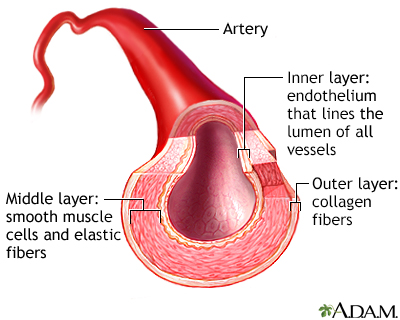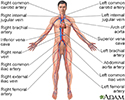Polyarteritis nodosa
Periarteritis nodosa; PAN; Systemic necrotizing vasculitisPolyarteritis nodosa is a serious inflammatory blood vessel disease. The small and medium-sized arteries become swollen and damaged.
Causes
Arteries are the blood vessels that carry oxygen-rich blood to organs and tissues. The cause of polyarteritis nodosa is unknown. The condition occurs when certain immune cells attack the affected arteries. The tissues that are fed by the affected arteries do not get the oxygen and nourishment they need. Damage occurs as a result.
More adults than children get this disease.
People with active hepatitis B or hepatitis C may develop this disease.
Hepatitis B
Hepatitis B is irritation and swelling (inflammation) of the liver due to infection with the hepatitis B virus (HBV). Other types of viral hepatitis ...

Hepatitis C
Hepatitis C is a viral disease that leads to swelling (inflammation) of the liver. Other types of viral hepatitis include:Hepatitis AHepatitis BHepat...

Symptoms
Symptoms are caused by damage to affected organs. The skin, joints, muscle, gastrointestinal tract, heart, kidneys, and nervous system are often affected.
Symptoms include:
- Abdominal pain
Abdominal pain
Abdominal pain is pain that you feel anywhere between your chest and groin. This is often referred to as the stomach region or belly.
 ImageRead Article Now Book Mark Article
ImageRead Article Now Book Mark Article - Decreased appetite
Decreased appetite
A decreased appetite is when your desire to eat is reduced. The medical term for a loss of appetite is anorexia.
Read Article Now Book Mark Article - Fatigue
Fatigue
Fatigue is a feeling of weariness, tiredness, or lack of energy.
Read Article Now Book Mark Article - Fever
Fever
Fever is the temporary increase in the body's temperature in response to a disease or illness. A child has a fever when the temperature is at or abov...
 ImageRead Article Now Book Mark Article
ImageRead Article Now Book Mark Article - Joint aches
- Muscle aches
Muscle aches
Muscle aches and pains are common and can involve more than one muscle. Muscle pain also can involve ligaments, tendons, and fascia. Fascias are th...
 ImageRead Article Now Book Mark Article
ImageRead Article Now Book Mark Article - Unintentional weight loss
Unintentional weight loss
Unexplained weight loss is a decrease in body weight, when you did not try to lose the weight on your own. Many people gain and lose weight. Uninten...
Read Article Now Book Mark Article - Weakness
If nerves are affected, you may have numbness, pain, burning, and weakness. Damage to the nervous system may cause strokes or seizures.
Strokes
A stroke occurs when blood flow to a part of the brain stops. A stroke is sometimes called a "brain attack. " If blood flow is cut off for longer th...

Seizures
A seizure is the physical changes in behavior that occurs during an episode of specific types of abnormal electrical activity in the brain. The term ...

Exams and Tests
No specific lab tests are available to diagnose polyarteritis nodosa. There are a number of disorders that have features similar to polyarteritis nodosa. These are known as "mimics."
You will have a complete physical exam.
Lab tests that can help make the diagnosis and rule out mimics include:
- Complete blood count (CBC) with differential, creatinine, tests for hepatitis B and C, and urinalysis
Complete blood count
A complete blood count (CBC) test measures the following:The number of white blood cells (WBC count)The number of red blood cells (RBC count)The numb...
 ImageRead Article Now Book Mark Article
ImageRead Article Now Book Mark Article - Erythrocyte sedimentation rate (ESR) or C-reactive protein (CRP)
Erythrocyte sedimentation rate
ESR stands for erythrocyte sedimentation rate. It is commonly called a "sed rate. "It is a test that indirectly measures the level of certain protei...
 ImageRead Article Now Book Mark Article
ImageRead Article Now Book Mark ArticleC-reactive protein
C-reactive protein (CRP) is produced by the liver. The level of CRP rises when there is inflammation in the body. It is one of a group of proteins,...
 ImageRead Article Now Book Mark Article
ImageRead Article Now Book Mark Article - Serum protein electrophoresis, cryoglobulins
- Serum complement levels
- Arteriogram
Arteriogram
An arteriogram is an imaging test that uses x-rays and a special dye to see inside the arteries. It can be used to view arteries in the heart, brain...
 ImageRead Article Now Book Mark Article
ImageRead Article Now Book Mark Article - Tissue biopsy
Biopsy
A biopsy is the removal of a small piece of tissue for laboratory examination.
Read Article Now Book Mark Article - Other blood tests will be done to rule out similar conditions, such as systemic lupus erythematosus (ANA) or granulomatosis with polyangiitis (ANCA)
Systemic lupus erythematosus
Systemic lupus erythematosus (SLE) is an autoimmune disease. In this disease, the immune system of the body mistakenly attacks healthy tissue. It c...
 ImageRead Article Now Book Mark Article
ImageRead Article Now Book Mark ArticleGranulomatosis with polyangiitis
Granulomatosis with polyangiitis (GPA) is a rare disorder in which blood vessels become inflamed. This leads to damage in major organs of the body. ...
 ImageRead Article Now Book Mark Article
ImageRead Article Now Book Mark Article - Test for HIV
Test for HIV
In general, testing for the human immunodeficiency virus (HIV) is a 2-step process that involves a screening test and follow-up tests often called co...
 ImageRead Article Now Book Mark Article
ImageRead Article Now Book Mark Article - Test for hepatitis B and hepatitis C
- Cryoglobulins
Cryoglobulins
Cryoglobulins are antibodies that become solid or gel-like at low temperatures in the laboratory. This article describes the blood test used to chec...
 ImageRead Article Now Book Mark Article
ImageRead Article Now Book Mark Article - Anti-phospholipid antibodies
- Blood cultures
Blood cultures
A blood culture is a laboratory test to check for bacteria or other germs in a blood sample.
 ImageRead Article Now Book Mark Article
ImageRead Article Now Book Mark Article
Treatment
Treatment involves medicines to suppress inflammation and the immune system. These may include steroids, such as prednisone. Similar medicines, such as azathioprine, methotrexate or mycophenolate that allow for reducing the dose of steroids are often used as well. Cyclophosphamide is used in severe cases.
For polyarteritis nodosa related to hepatitis, treatment may involve plasmapheresis and antiviral medicines.
Outlook (Prognosis)
Current treatments with steroids and other drugs that suppress the immune system (such as azathioprine or cyclophosphamide) can improve symptoms and the chance of long-term survival.
The most serious complications most often involve the kidneys and gastrointestinal tract.
Without treatment, the outlook is poor.
Possible Complications
Complications may include:
- Heart attack
Heart attack
Most heart attacks are caused by a blood clot that blocks one of the coronary arteries. The coronary arteries bring blood and oxygen to the heart. ...
 ImageRead Article Now Book Mark Article
ImageRead Article Now Book Mark Article - Intestinal necrosis and perforation
Intestinal necrosis
Intestinal ischemia and infarction occurs when there is a narrowing or blockage of one or more of the arteries that supply the small intestine....
 ImageRead Article Now Book Mark Article
ImageRead Article Now Book Mark Article - Kidney failure
Kidney failure
Acute kidney failure is the rapid (less than 2 days) loss of your kidneys' ability to remove waste and help balance fluids and electrolytes in your b...
 ImageRead Article Now Book Mark Article
ImageRead Article Now Book Mark Article - Stroke
Stroke
A stroke occurs when blood flow to a part of the brain stops. A stroke is sometimes called a "brain attack. " If blood flow is cut off for longer th...
 ImageRead Article Now Book Mark Article
ImageRead Article Now Book Mark Article
When to Contact a Medical Professional
Contact your health care provider if you develop symptoms of this disorder. Early diagnosis and treatment may improve the chance of a good outcome.
Prevention
There is no known prevention. However, early treatment can prevent some damage and symptoms.
References
Luqmani R, Awisat A. Polyarteritis nodosa and related disorders. In: Firestein GS, Budd RC, Gabriel SE, Koretzky GA, McInnes IB, O'Dell JR, eds. Firestein & Kelley's Textbook of Rheumatology. 11th ed. Philadelphia, PA: Elsevier; 2021:chap 95.
Puéchal X, Pagnoux C, Baron G, et al. Adding azathioprine to remission-induction glucocorticoids for eosinophilic granulomatosis with polyangiitis (Churg-Strauss), microscopic polyangiitis, or polyarteritis nodosa without poor prognosis factors: a randomized, controlled trial. Arthritis Rheumatol. 2017;69(11):2175-2186. PMID: 28678392 www.pubmed.ncbi.nlm.nih.gov/28678392/.
Shanmugam VK. Vasculitis and other uncommon arteriopathies. In: Sidawy AN, Perler BA, eds. Rutherford's Vascular Surgery and Endovascular Therapy. 10th ed. Philadelphia, PA: Elsevier; 2023:chap 138.
Stone JH. The systemic vasculitides. In: Goldman L, Schafer AI, eds. Goldman-Cecil Medicine. 26th ed. Philadelphia, PA: Elsevier; 2020:chap 254.
Artery cut section - illustration
The structure of blood vessel walls is important in the regulation of blood flow. The tunica media contains smooth muscle fibers which contract to either dilate or constrict the size of the vessel. These small changes in the vessel lumen can greatly influence blood pressure and blood flow. Therefore, the tunica media plays an important role in maintaining blood pressure and continuous blood circulation.
Artery cut section
illustration
Microscopic polyarteritis 2 - illustration
Polyarteritis nodosa, seen here on a lower extremity, produces painful, erythematous nodules. Arteries in the deep dermis and upper fat show neutrophilic infiltration.
Microscopic polyarteritis 2
illustration
Circulatory system - illustration
Blood used by the body is brought back to the heart and lungs by the veins of the body. Once the blood has gathered more oxygen from the lungs, it is pumped back out to the body through the arteries.
Circulatory system
illustration
Artery cut section - illustration
The structure of blood vessel walls is important in the regulation of blood flow. The tunica media contains smooth muscle fibers which contract to either dilate or constrict the size of the vessel. These small changes in the vessel lumen can greatly influence blood pressure and blood flow. Therefore, the tunica media plays an important role in maintaining blood pressure and continuous blood circulation.
Artery cut section
illustration
Microscopic polyarteritis 2 - illustration
Polyarteritis nodosa, seen here on a lower extremity, produces painful, erythematous nodules. Arteries in the deep dermis and upper fat show neutrophilic infiltration.
Microscopic polyarteritis 2
illustration
Circulatory system - illustration
Blood used by the body is brought back to the heart and lungs by the veins of the body. Once the blood has gathered more oxygen from the lungs, it is pumped back out to the body through the arteries.
Circulatory system
illustration
Review Date: 4/19/2022
Reviewed By: Diane M. Horowitz, MD, Rheumatology and Internal Medicine, Northwell Health, Great Neck, NY. Review provided by VeriMed Healthcare Network. Also reviewed by David C. Dugdale, MD, Medical Director, Brenda Conaway, Editorial Director, and the A.D.A.M. Editorial team.






